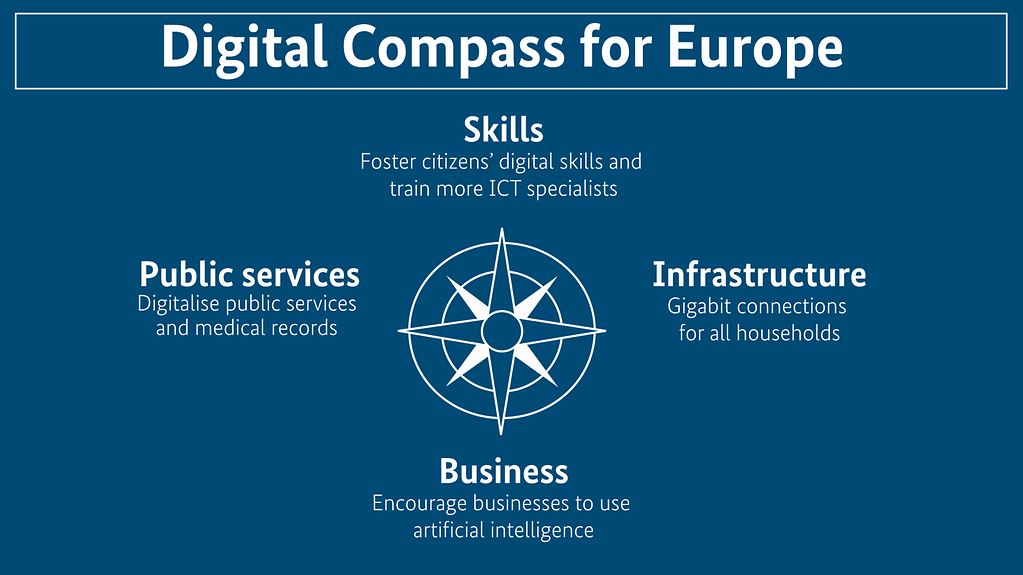FAQs on Europe’s digital policy
On 25 and 26 March, the EU heads of state and government will be discussing important economic matters in a video conference. Europe’s digital future will be a pivotal issue. Here is what you should know about the EU’s digital policy.
3 min reading time

The European Commission has presented concrete objectives for a common European digital policy for the period up to 2030.
Digital Compass for Europe
Skills
Foster citizens’ digital skills and train more ICT specialists
Infrastructure
Gigabit connections for all households
Business
Encourage businesses to use artificial intelligence
Public services
Digitalise public services and medical records
Photo: Bundesregierung
Why is the EU working on a common digital policy?
Digital transformation is crucial for economic recovery, prosperity, security and competitiveness in the 21st century. That applies to all member states of the European Union. Progress on digitalisation can be achieved more rapidly across Europe through joint efforts.
The EU has also demonstrated in the non-digital world that its rules and standards can become the norm worldwide. This will only be achieved in the digital world if EU member states pull together. Europe’s goal is to see a socially balanced digital world that reflects European values and basic rights and where people feel safe. To this end, we need a common European digital policy and a digital single market.
What digital goals has the EU set itself for 2030?
The European Commission has set forth concrete objectives for a common European digital policy to be achieved by 2030. It has thus established important milestones for digital transformation in Europe. The objectives cover four areas:
- Skills: By 2030 a minimum of 80 per cent of adults in Europe are to have at least basic digital skills. 20 million people are to be employed as information and communication technology (ICT) specialists, with convergence between women and men.
- Infrastructure: By 2030 all European households are to be covered by a Gigabit-network. Europe’s production of semiconductors is to be doubled, to a level of 20 per cent of global production. A total of 10,000 climate neutral highly secure edge nodes (computing centres) are to be established along with a first quantum computer.
- Business: By 2030 three in four business are to use cloud computing services, big data and artificial intelligence. The number of unicorns (successful start-ups with a particularly good market valuation) is to double in Europe.
- Public services: All key public services should be available online, along with digital medical records. 80 per cent of EU citizens are to use a digital ID solution.
What is the Digital Compass?
The Digital Compass was intended to point the way forward for digital transformation by 2030. It indicates the implementation status of efforts to achieve the above objectives. A traffic light system is used to show what progress the EU member states are making on implementation. The Digital Compass also makes it easier to achieve the objectives, by harnessing a range of different instruments, including multi-country projects.
Multi-country projects bring together investment from the EU budget, the member states and the private sector. This is used to finance projects to close critical digital gaps. This could, for instance, include setting up an AI-supported network of security centres that would detect and repel cyber attacks at an early stage.
What is digital sovereignty and why is it important for Europe?
Digital sovereignty in Europe means the ability and the capability of the EU to play its role in the digital world independently, safely, securely and in a self-determined manner. The COVID-19 pandemic has demonstrated Europe’s digital dependencies. This applies both to services like cloud computing services and to technology, such as the manufacture of semiconductors that are needed in the production of electric and electronic products including electric vehicles and solar power plants.
Digital sovereignty is thus a declared goal of the EU. Digital sovereignty does not mean that Europeans need to be able to do everything, but they must decide for themselves where Europe needs to be independent. That is why the EU is pursuing a strategy of developing capacities and skills in areas where it wants greater self-determination.
Does the EU also provide financial support for digital transformation?
The Next Generation EU recovery fund in particular will provide for greater common investment in digital transformation. This fund will provide 672.5 billion euros, 20 per cent of which will be earmarked for digital projects for the future and European digital innovations. Germany in fact will dedicate 40 per cent to support digitalisation. The EU funding is to be used, for instance, to invest in research and digital infrastructure and to foster digital transformation in the private sector.